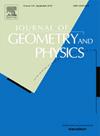由规范群作用诱导的规范等价关系下的矩阵Lax对和格方程的miura型变换
IF 1.2
3区 数学
Q1 MATHEMATICS
引用次数: 0
摘要
本文探讨了微分-差分矩阵Lax表示(Lax对)、规范变换和离散miura型变换(MTs)之间的相互联系,它们属于可积微分-差分(格)方程理论中的主要工具。对于一个给定方程,如果两个矩阵松弛表示(mlr)中的一个可以通过(局部)矩阵规范变换从另一个得到,则称它们是规范等价的。矩阵规范变换构成了一个称为矩阵规范群的无限维群,它自然作用于给定方程的mlr集合。当且仅当两个mlr属于矩阵规范群作用的同一轨道时,它们是规范等价的。对于一类广义的(矢量)进化微分-差分方程的mlr,我们给出了以下问题的结果:何时以及如何通过矩阵规范变换简化给定的MLR,并将MLR转化为适合构造mt的形式?如果一个MLR与一个平凡的MLR是规范等价的,那么它就被称为伪MLR。如何确定一个给定的MLR是不是假的?在这里和另一份出版物中(与E. christov合作),我们将本文的结果应用于以下可积的例子:•由D. Zhang和D. Chen在他们关于演化格方程[28]的哈密顿结构的工作中引入的一个3分量格,•与成田-伊托- bogoyavlensky格相关的(- 2,2)阶的有理1分量方程,•与格w3代数相关的2分量Boussinesq格,•由G. Marí Beffa和王静平在他们关于的哈密顿演化的工作中引入的一个2分量方程多边形[2]),它描述了由平面多边形的不变量演化引起的不变量演化。这允许我们构建新的可积方程(使用新的mlr),通过新的mt连接到已知方程。本文章由计算机程序翻译,如有差异,请以英文原文为准。
Matrix Lax pairs under the gauge equivalence relation induced by the gauge group action and Miura-type transformations for lattice equations
In this paper we explore interconnections of differential-difference matrix Lax representations (Lax pairs), gauge transformations, and discrete Miura-type transformations (MTs), which belong to the main tools in the theory of integrable differential-difference (lattice) equations.
For a given equation, two matrix Lax representations (MLRs) are said to be gauge equivalent if one of them can be obtained from the other by means of a (local) matrix gauge transformation. Matrix gauge transformations constitute an infinite-dimensional group called the matrix gauge group, which acts naturally on the set of MLRs of a given equation. Two MLRs are gauge equivalent if and only if they belong to the same orbit of the matrix gauge group action.
For a wide class of MLRs of (vector) evolutionary differential-difference equations, we present results on the following questions:
- 1.When and how can one simplify a given MLR by matrix gauge transformations and bring the MLR to a form suitable for constructing MTs?
- 2.A MLR is called fake if it is gauge equivalent to a trivial MLR. How to determine whether a given MLR is not fake?
Here and in a different publication (with E. Chistov), we apply results of the present paper to the following integrable examples:
- •a 3-component lattice introduced by D. Zhang and D. Chen in their work on Hamiltonian structures of evolutionary lattice equations [28],
- •some rational 1-component equations of order related to the Narita–Itoh–Bogoyavlensky lattice,
- •the 2-component Boussinesq lattice related to the lattice -algebra,
- •a 2-component equation (introduced by G. Marí Beffa and Jing Ping Wang in their work on Hamiltonian evolutions of polygons [2]) which describes the evolution induced on invariants by an invariant evolution of planar polygons.
求助全文
通过发布文献求助,成功后即可免费获取论文全文。
去求助
来源期刊

Journal of Geometry and Physics
物理-物理:数学物理
CiteScore
2.90
自引率
6.70%
发文量
205
审稿时长
64 days
期刊介绍:
The Journal of Geometry and Physics is an International Journal in Mathematical Physics. The Journal stimulates the interaction between geometry and physics by publishing primary research, feature and review articles which are of common interest to practitioners in both fields.
The Journal of Geometry and Physics now also accepts Letters, allowing for rapid dissemination of outstanding results in the field of geometry and physics. Letters should not exceed a maximum of five printed journal pages (or contain a maximum of 5000 words) and should contain novel, cutting edge results that are of broad interest to the mathematical physics community. Only Letters which are expected to make a significant addition to the literature in the field will be considered.
The Journal covers the following areas of research:
Methods of:
• Algebraic and Differential Topology
• Algebraic Geometry
• Real and Complex Differential Geometry
• Riemannian Manifolds
• Symplectic Geometry
• Global Analysis, Analysis on Manifolds
• Geometric Theory of Differential Equations
• Geometric Control Theory
• Lie Groups and Lie Algebras
• Supermanifolds and Supergroups
• Discrete Geometry
• Spinors and Twistors
Applications to:
• Strings and Superstrings
• Noncommutative Topology and Geometry
• Quantum Groups
• Geometric Methods in Statistics and Probability
• Geometry Approaches to Thermodynamics
• Classical and Quantum Dynamical Systems
• Classical and Quantum Integrable Systems
• Classical and Quantum Mechanics
• Classical and Quantum Field Theory
• General Relativity
• Quantum Information
• Quantum Gravity
 求助内容:
求助内容: 应助结果提醒方式:
应助结果提醒方式:


